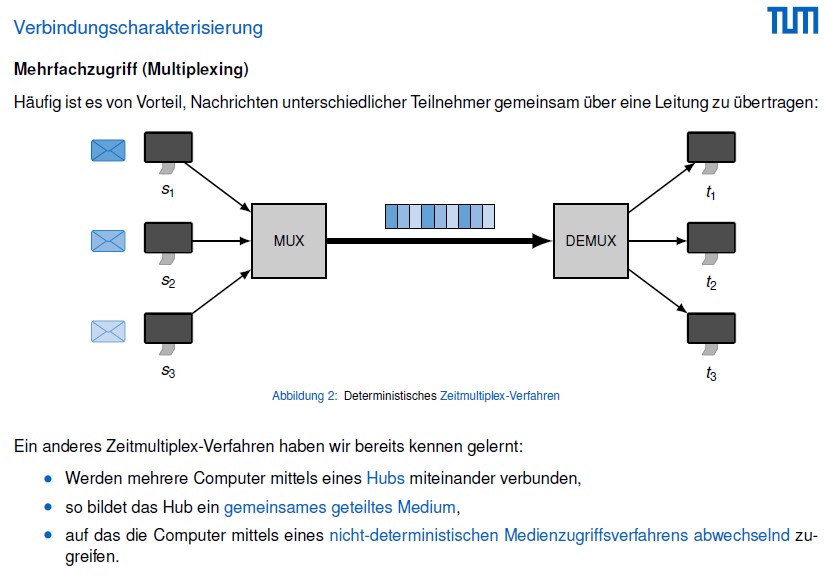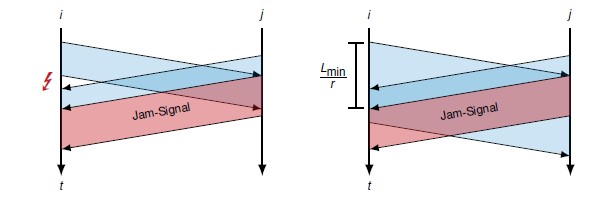Functionally important and single data link layer
Verbindungscharakterisierung
The connection between two nodes will have various properties as follows:Übertragungsrate, Übertragungsverzögerung, Übertragungsrichtung, and Mehrfachzugriff (Multiplexing)。
Point-to-point channels
Übertragungsrate
The time that the data is placed on top of the channel we call Serialisierungszeit and is denoted as $t_s$, L is the size of the data to be transferred, r is the transfer rate, and so $$ t_s = \frac{L}{r} $$ Here, $t_s$ can be thought of as the transmission delay, the time that will be used to transmit this data.
Ausbreitungsverzögerung
As the name implies, the propagation delay, unlike the above, is the time it will take for the signal to travel from one segment to the other in the channel. $$ t_p = \frac{d}{vc_0} $$ $c_0$is the speed of light, and v is a constant, related to the transmission medium.
Gesamtverzögerung
$t_d$ That is, the total delay is the sum of the above two items
Bandbreitenverzögerungsprodukt
This is known as broadband delay, precisely because propagation in the channel inevitably takes time and we need a certain capacity to store. $$ C = t_p r = \frac{d}{vc_0} r $$ The unit is bit.
Übertragungsrichtung

Übertragungsrichtung
Data Link Layer for Broadcast Channels
Generally speaking here we will use time division multiplexing (Zeitmultiplex), i.e. the use of a channel to achieve communication between different ports, based on a non-deterministic approach (concurrent access) in packet networks (Ethernet, wireless LANs).
As for multiplexing I think the diagram above the professor’s SLIDE is clear:
Multiplexing
ALOHA and Sorted ALOHA
CSMA, CSMA/CD, CSMA/CA
CSMA actually refers to Carrier Sense Multiple Access, which is a simple optimization of the previous sorted ALOHA, i.e. “listen before talk”.。
CSMA/CD
Known as Carrier Listening Collision Listening Multipoint Access/Collision Detection, which is the protocol used by Ethernet, divided into two parts: i.e. “Listening before sending”, each station has to detect whether there are other stations on the bus sending data before sending data, and if so, temporarily do not send data and wait for the channel to be free before sending. There is no “carrier” on the bus, it is just a customary name here; - Collision detection: i.e. “listen while sending”, the adapter detects the signal voltage on the channel while sending data, so as to determine whether other stations are also sending data when it is sending data. The adapter detects the signal voltage on the channel while sending data in order to determine whether other stations are sending data while it is sending data. When the signal voltage on the bus varies greatly when the data is sent at the same time and exceeds a certain threshold value, it is considered that at least two stations on the bus are sending data at the same time, indicating a collision. In this case, the signal on the bus is distorted and cannot be recovered. Therefore, every station that is sending data, once a collision is detected, the adapter has to stop sending immediately to avoid wasting network resources and wait for a random period of time before sending again. If the propagation delay of the upper signal over the link is considered, the process is similar to this.

CSMA/CD
Each endpoint has the possibility to encounter a collision within a short period of time after it sends the data, which is the maximum time for two one-way trips, and this time is called the “contention period”. Only by passing the contention period can we be sure that the transmission will not collide. It is for this reason that Ethernet specifies a minimum length of 64 bytes for data frames, and all frames less than this length are considered to be dropped due to collisions. When we receive at least 64 bytes we can assume that there is no collision between them.
CSMA/CD cannot transmit and receive at the same time, so it is Halbdulplex, which is a half-duplex protocol, i.e. alternating communication in both directions.
CSMA/CA
CSMA/CD cannot be used in wired LANs (wireless LANs), because even if the sent message is long enough, collision cannot always be detected. CA here is actually colision avoidance, which means that it cannot detect conflicts on the channel while sending packets, but can only try to “avoid” them. For example, if computer A and computer C send a control message to computer B at the same time, they will arrive at computer B at the same time, resulting in a conflict. When such a conflict occurs, the sender can wait for a random period of time, and then resend the control message. Because control messages are much shorter than data frames, the likelihood of a second conflict is also much lower than with traditional Ethernet. Eventually a control message will arrive correctly, and then Computer B sends a response message. Usually CSMA/CA uses the ACK signal to avoid conflicts, that is, the client only confirms that the sent data has arrived correctly at the destination when it receives the ACK signal back on the network.
Here’s what the professor’s slide says:
- Wenn Medium frei, übertrage mit Wahrscheinlichkeit p oder verzögere mit Wahrscheinlichkeit 1 − p um eine feste Zeit dann 1.
- Wenn Medium belegt, warte bis frei, dann 1.
Encapsulation into frames
Encapsulation simply means splitting and packing packets in advance, attaching the destination address, local address, and some bytes for error correction to the packet being sent. The rules that are followed and negotiated between the two communicating parties when processing the packet are the protocol.
The packet transmitted at the network layer is transmitted in the data link layer as a frame (Rahmen). The packet arrives at the data link layer, and the protocol header and protocol tail of the data link layer are added to form a data frame.
MAC Address
is the address in the ROM of the adapter (hence the name adapter address or adapter identifier EUI-48) that is solidified in each computer on the LAN, determined by the hardware vendor, and does not change. As long as the adapter remains the same, it remains the same. It is the “name” or identifier of each station. If a host or router connected to the LAN has more than one adapter installed, then such host or router has more than one “address”, that is, this 48-bit address should be the identifier of an interface. Of course, it is possible to change the mac address with the appropriate software.